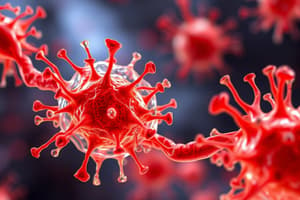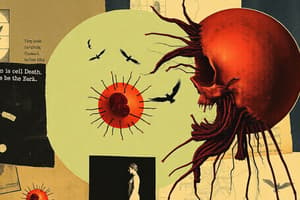Podcast
Questions and Answers
What is the role of phosphatidylserine in apoptotic cells?
What is the role of phosphatidylserine in apoptotic cells?
- It serves as a marker for phagocytosis by macrophages. (correct)
- It maintains the mitochondrial membrane potential.
- It induces inflammation in neighboring cells.
- It supports ATP production.
What is a primary characteristic of caspases in the apoptosis process?
What is a primary characteristic of caspases in the apoptosis process?
- They have a cysteine at the active site. (correct)
- They are activated by oxidative stress.
- They cleave at specific serine residues.
- They are produced as active enzymes.
During apoptosis, what happens to the chromosomal DNA?
During apoptosis, what happens to the chromosomal DNA?
- It enhances the gene expression of survival genes.
- It remains intact and functional.
- It becomes hypermethylated.
- It is cleaved into fragments of distinct sizes. (correct)
What triggers the activation of procaspases in the apoptosis cascade?
What triggers the activation of procaspases in the apoptosis cascade?
What occurs to the mitochondrial membrane potential during apoptosis?
What occurs to the mitochondrial membrane potential during apoptosis?
What is the primary role of apoptosis in adult tissues?
What is the primary role of apoptosis in adult tissues?
Which characteristic morphological change is associated with apoptosis?
Which characteristic morphological change is associated with apoptosis?
What term describes the controlled cell death process in which cells kill themselves?
What term describes the controlled cell death process in which cells kill themselves?
How does the cell surface change during apoptosis?
How does the cell surface change during apoptosis?
What does the term 'apoptotic bodies' refer to?
What does the term 'apoptotic bodies' refer to?
During animal development, apoptosis is crucial for which of the following processes?
During animal development, apoptosis is crucial for which of the following processes?
What does the term 'falling off' refer to in the context of apoptosis?
What does the term 'falling off' refer to in the context of apoptosis?
Which statement accurately describes the biochemical changes in apoptotic cells?
Which statement accurately describes the biochemical changes in apoptotic cells?
What is the role of the caspase recruitment domain (CARD) in initiator procaspases?
What is the role of the caspase recruitment domain (CARD) in initiator procaspases?
Which of the following describes the process of procaspase activation?
Which of the following describes the process of procaspase activation?
What happens after initiator procaspases are activated?
What happens after initiator procaspases are activated?
Which of the following cleaves target proteins leading to controlled cell death?
Which of the following cleaves target proteins leading to controlled cell death?
Which of the following proteins is NOT typically cleaved by executioner caspases?
Which of the following proteins is NOT typically cleaved by executioner caspases?
What are the two main pathways that activate the caspase cascade leading to apoptosis?
What are the two main pathways that activate the caspase cascade leading to apoptosis?
Which initiator procaspase is commonly associated with the intrinsic pathway?
Which initiator procaspase is commonly associated with the intrinsic pathway?
Which of the following statements about caspases is true?
Which of the following statements about caspases is true?
What is the initial signal that activates the extrinsic pathway of apoptosis?
What is the initial signal that activates the extrinsic pathway of apoptosis?
Which component of the Fas death receptor is crucial for initiating apoptosis?
Which component of the Fas death receptor is crucial for initiating apoptosis?
What role does the adaptor protein FADD play in the extrinsic pathway?
What role does the adaptor protein FADD play in the extrinsic pathway?
What happens within the death-inducing signaling complex (DISC)?
What happens within the death-inducing signaling complex (DISC)?
Which of the following describes a mechanism that inhibits the extrinsic pathway of apoptosis?
Which of the following describes a mechanism that inhibits the extrinsic pathway of apoptosis?
Which type of cellular response can lead to the activation of the intrinsic pathway rather than the extrinsic pathway?
Which type of cellular response can lead to the activation of the intrinsic pathway rather than the extrinsic pathway?
What does the FLIP protein resemble and how does it function in inhibiting apoptosis?
What does the FLIP protein resemble and how does it function in inhibiting apoptosis?
What is a function of activated caspase-8 and caspase-10 in the cascade leading to apoptosis?
What is a function of activated caspase-8 and caspase-10 in the cascade leading to apoptosis?
What initiates the intrinsic pathway of apoptosis?
What initiates the intrinsic pathway of apoptosis?
What is the role of BH123 proteins in the intrinsic pathway?
What is the role of BH123 proteins in the intrinsic pathway?
How do BH3-only proteins contribute to apoptosis?
How do BH3-only proteins contribute to apoptosis?
What is the consequence of cytochrome c being released from the mitochondria?
What is the consequence of cytochrome c being released from the mitochondria?
What is a characteristic of anti-apoptotic Bcl2 proteins?
What is a characteristic of anti-apoptotic Bcl2 proteins?
What structure is formed when Apaf1 oligomerizes upon cytochrome c binding?
What structure is formed when Apaf1 oligomerizes upon cytochrome c binding?
Which proteins are considered pro-apoptotic in the context of the intrinsic pathway?
Which proteins are considered pro-apoptotic in the context of the intrinsic pathway?
Flashcards
Apoptosis
Apoptosis
A process of controlled cell death that is essential for normal development and tissue homeostasis.
Morphological Changes in Apoptosis
Morphological Changes in Apoptosis
Cells undergoing apoptosis shrink, condense, and break up into membrane-enclosed fragments called apoptotic bodies.
Macrophage
Macrophage
A particular type of cell that engulfs and digests apoptotic bodies.
Apoptosis in Development
Apoptosis in Development
Signup and view all the flashcards
Apoptosis in Adult Tissues
Apoptosis in Adult Tissues
Signup and view all the flashcards
Biochemical Changes in Apoptosis
Biochemical Changes in Apoptosis
Signup and view all the flashcards
Programmed Cell Death
Programmed Cell Death
Signup and view all the flashcards
Cell Homeostasis
Cell Homeostasis
Signup and view all the flashcards
Endonuclease
Endonuclease
Signup and view all the flashcards
Phosphatidylserine
Phosphatidylserine
Signup and view all the flashcards
Caspases
Caspases
Signup and view all the flashcards
Procaspases
Procaspases
Signup and view all the flashcards
CARD (Caspase Recruitment Domain)
CARD (Caspase Recruitment Domain)
Signup and view all the flashcards
CARD (Caspase Recruitment Domain)
CARD (Caspase Recruitment Domain)
Signup and view all the flashcards
Initiator Procaspase
Initiator Procaspase
Signup and view all the flashcards
Executioner Procaspase
Executioner Procaspase
Signup and view all the flashcards
Procaspase Activation
Procaspase Activation
Signup and view all the flashcards
Extrinsic Pathway of Apoptosis
Extrinsic Pathway of Apoptosis
Signup and view all the flashcards
Intrinsic Pathway of Apoptosis
Intrinsic Pathway of Apoptosis
Signup and view all the flashcards
What are Fas death receptors?
What are Fas death receptors?
Signup and view all the flashcards
What is Fas ligand?
What is Fas ligand?
Signup and view all the flashcards
What is FADD?
What is FADD?
Signup and view all the flashcards
What is a DISC?
What is a DISC?
Signup and view all the flashcards
What is the caspase cascade?
What is the caspase cascade?
Signup and view all the flashcards
What are decoy receptors?
What are decoy receptors?
Signup and view all the flashcards
What is FLIP?
What is FLIP?
Signup and view all the flashcards
What is the intrinsic pathway of apoptosis?
What is the intrinsic pathway of apoptosis?
Signup and view all the flashcards
What is cytochrome c's role in both normal cell function and apoptosis?
What is cytochrome c's role in both normal cell function and apoptosis?
Signup and view all the flashcards
What does Apaf1 do after cytochrome c is released?
What does Apaf1 do after cytochrome c is released?
Signup and view all the flashcards
What is the apoptosome?
What is the apoptosome?
Signup and view all the flashcards
What controls the release of cytochrome c from mitochondria?
What controls the release of cytochrome c from mitochondria?
Signup and view all the flashcards
Which Bcl2 proteins promote apoptosis?
Which Bcl2 proteins promote apoptosis?
Signup and view all the flashcards
Which Bcl2 proteins prevent apoptosis?
Which Bcl2 proteins prevent apoptosis?
Signup and view all the flashcards
What is the role of 'BH3-only' proteins in the intrinsic pathway of apoptosis?
What is the role of 'BH3-only' proteins in the intrinsic pathway of apoptosis?
Signup and view all the flashcards
Study Notes
Apoptosis
- Cell death is vital for animal and plant development, continuing into adulthood.
- In a healthy adult human, billions of cells die every hour in the bone marrow and intestines.
- Tissue size remains consistent as cell division balances cell death.
- Normal cell death is a form of cellular suicide.
- Cells undergo a controlled death process called programmed cell death.
Apoptosis: Definition
- Apoptosis is the main type of programmed cell death.
- It originates from the Greek word meaning "falling off."
- Apoptotic cells have altered cell surfaces, enabling rapid engulfment by macrophages before spillage of their contents.
- This protects against damaging inflammation.
Apoptosis: Morphology
- Apoptotic cells display distinctive morphological changes.
- Cells shrink and condense.
- Cytoskeleton structure disintegrates.
- Nuclear chromatin condenses and breaks into fragments.
- Large cells often fragment into membrane-bound apoptotic bodies.
- Cell surface or apoptotic bodies' chemistry alters.
Apoptosis: Classical Examples
- Crucial in animal development for shaping structures like hands and feet, and regulating nervous system cells.
- Contributes to the development of adaptive immune system components.
- In metamorphosis, eliminating unnecessary cells.
- In adult tissues, removing malfunctioning or dangerous cells.
- Essential for eliminating cells no longer needed following infections.
- Maintains a ready pool of short-lived immune cells, like neutrophils in bone marrow.
Apoptosis: Biochemistry
- Biochemical changes help identify apoptotic cells.
- During apoptosis, endonuclease fragments DNA into unique sizes.
- These DNA fragments form a characteristic "ladder" pattern in gel electrophoresis.
- Phosphatidylserine, a negatively charged phospholipid, moves from the inner to the outer leaflet of the cell membrane, acting as a marker for engulfment.
- Loss of transmembrane potential in mitochondria, releasing cytochrome c.
Apoptosis Machinery
- Apoptosis relies on a family of caspase proteases.
- Caspases have a cysteine at their active site and cleave aspartic acid residues.
- Caspases are initially inactive precursors (procaspases).
- Proteolytic cleavage activates them.
Apoptosis: The Beginning
- Healthy cells constantly produce procaspases.
- Procaspase activation requires an initiating trigger.
- Initiator procaspases contain a prodomain with a caspase recruitment domain (CARD).
- CARDs allow assembly with adaptor proteins and activation complexes when required.
- Once initiator procaspases are close together, they activate each other, making the process irreversible.
Procaspase Activation
- Procaspases have large and small subunits.
- Subunits form a heterodimer that then combines with another to make a functional active tetramer.
- The first activated procaspases are initiator procaspases, activating subsequent executioner procaspases.
- Executioner caspases cleave essential proteins in the cell, leading to its demise.
Not all caspases mediate apoptosis
- Some caspases play roles in inflammation.
- Caspases involved in apoptosis fall into initiator (e.g., caspase 8, 9) and executioner (e.g., caspase 3, 7) groups.
Target Proteins
- Executioner caspases cleave target proteins, affecting the nuclear lamina, endonucleases, cytoskeleton, and cell-cell adhesion proteins.
Signaling Pathways (Extrinsic)
- Cell surface Fas death receptors trigger the extrinsic pathway.
- They belong to the TNF receptor family.
- Receptors are homotrimers with extracellular ligand-binding domains, a transmembrane domain, and intracellular death domains.
- They are activated by external signals.
Signaling Pathways (Intrinsic)
- Intrinsic pathways are activated by internal stimuli, such as DNA damage, lack of oxygen, or nutrient deprivation.
- Mitochondria release cytochrome c, initiating the intrinsic pathway through the activation of Apaf1.
- Apaf1 binds with cytochorome c and procaspase-9 to form the apoptosome.
Regulation Intrinsic Pathway
- Bcl2 proteins tightly control the intrinsic pathway.
- Different Bcl2 family members regulate the balance between apoptosis and survival.
- Pro-apoptotic members (BH123) instigate apoptosis upon activation.
- Anti-apoptotic (e.g., Bcl2) members prevent apoptosis.
- BH3-only proteins are a crucial regulatory link between anti- and pro-apoptotic Bcl2 proteins.
Regulation Intrinsic Pathway IAPs
- IAPs (inhibitors of apoptosis) are proteins that prevent excessive apoptosis.
- They bind to and inhibit activated caspases, preventing uncontrolled processes.
- Anti-IAPs are also present and can overcome this inhibition for programmed cell death.
Extracellular Survival Factors
- Survival factors can either inhibit or facilitate apoptosis, in large part from their interactions with intracellular molecules and pathways.
Summary
- Inappropriate apoptosis can contribute to various diseases.
- Imbalances in apoptosis, either too much or too little, significantly impact the body's health.
- Different cell death pathways control excessive or deficient apoptosis across the human body.
Studying That Suits You
Use AI to generate personalized quizzes and flashcards to suit your learning preferences.





